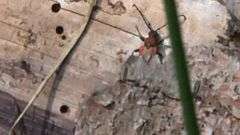Stictoleptura rubra
| Stictoleptura rubra | |
|---|---|
| | |
| Stictoleptura rubra, male | |
| | |
| Stictoleptura rubra, female | |
| Scientific classification | |
| Kingdom: | Animalia |
| Phylum: | Arthropoda |
| Class: | Insecta |
| Order: | Coleoptera |
| Family: | Cerambycidae |
| Genus: | Stictoleptura |
| Species: | S. rubra |
| Binomial name | |
| Stictoleptura rubra (Linnaeus, 1758) | |
| Synonyms | |
| |
Stictoleptura rubra, the Red-brown Longhorn Beetle, is a species of beetles belonging to the family Cerambycidae.

Subspecies
- Stictoleptura rubra dichroa (Blanchard, 1871)
- Stictoleptura rubra numidica (Peyerhimoff, 1917)
- Stictoleptura rubra rubra (Linnaeus, 1758)
- Stictoleptura rubra succedanea (Lewis, 1873)
Description
Stictoleptura rubra can reach a length of 10–20 millimetres (0.39–0.79 in).[2] This species has an evident sexual dimorphism, with variations in color and shape. Elytrae and pronotum of the females are uniformly reddish-brown or reddish-orange, while in males head and pronotum are black. Moreover the males have brown or pale ochre elytrae and often they are smaller and narrower than the females.[3]
Biology
Life cycle of this species lasts two - three years. Adults can be encountered from May to September, but mainly in July and August). They visit flowering plants for nectar and/or pollen, while larvae develop and feed within dead wood and tree stumps of coniferous trees (Picea, Pinus, Abies, Larix).[2][4] To develop and reach maturity they need nutrients provided by fungi.[5][6] Theirs gut contains cellulase-producing yeasts[7] to enable xylophagy, or wood-digestion.
Distribution
The species is found throughout the European mainland, Russia and North Africa. It can also be found in Turkey and Great Britain.[2][8][9]
References
- ↑ "Stictoleptura rubra (Linnaeus, 1758)". Biolib.cz. Retrieved February 22, 2012.
- 1 2 3 Cerambyx
- ↑ Nature Spot
- ↑ Stictoleptura rubra (Linnaeus, 1758) (Red Longhorn Beetle)
- ↑ Filipiak, Michał; Sobczyk, Łukasz; Weiner, January (9 April 2016). "Fungal Transformation of Tree Stumps into a Suitable Resource for Xylophagous Beetles via Changes in Elemental Ratios". Insects. 7 (2): 13. doi:10.3390/insects7020013.
- ↑ Filipiak, Michał; Weiner, January; Wilson, Richard A. (23 December 2014). "How to Make a Beetle Out of Wood: Multi-Elemental Stoichiometry of Wood Decay, Xylophagy and Fungivory". PLoS ONE. 9 (12): e115104. doi:10.1371/journal.pone.0115104.
- ↑ Grünwald, S.; M. Pilhofer; W. Höll (January 2010). "Microbial associations in gut systems of wood- and bark-inhabiting longhorned beetles Coleoptera: Cerambycidae]". Systematic and Applied Microbiology. 33 (1): 25–34. doi:10.1016/j.syapm.2009.10.002. ISSN 0723-2020. PMID 19962263. Retrieved June 11, 2010.
- ↑ "Stictoleptura rubra (Linnaeus, 1758)". Fauna Europaea. Retrieved February 22, 2012.
- ↑ Vitali F.: Cerambycoidea